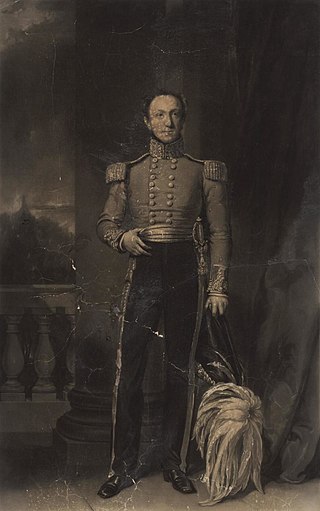Related Research Articles

Bridgwater is a historic market town and civil parish in Somerset, England. The town had a population of 41,276 at the 2021 census. Bridgwater is at the edge of the Somerset Levels, in level and well-wooded country. The town lies along both sides of the River Parrett; it has been a major inland port and trading centre since the industrial revolution. Most of its industrial bases still stand today. Its larger neighbour, Taunton, is linked to Bridgwater via a canal, the M5 motorway and the GWR railway line.

Henry Alford was an English churchman, theologian, textual critic, scholar, poet, hymnodist, and writer.

William Powell Frith was an English painter specialising in genre subjects and panoramic narrative works of life in the Victorian era. He was elected to the Royal Academy in 1853, presenting The Sleeping Model as his Diploma work. He has been described as the "greatest British painter of the social scene since Hogarth".
Henry Marc Brunel was an English civil engineer and the son of engineer Isambard Kingdom Brunel and grandson of civil engineer Marc Isambard Brunel best known for his design work on Tower Bridge built in partnership with Sir John Wolfe Barry.

Richard Bishop, also known as Richard M. Bishop and Papa Richard, was an American politician from the U.S. state of Ohio. Bishop served as the 34th governor of Ohio.

John Egerton, 3rd Earl of Bridgewater KB PC was a British nobleman from the Egerton family.

Froyle is a village and civil parish in the East Hampshire district of Hampshire, England. It is 3.6 miles (5.8 km) northeast of Alton. The nearest railway station is 2 miles (3.3 km) east of the village, at Bentley. According to the 2011 census, the parish had a population of 644 people. The village is divided into Upper Froyle, centred around the Church and Manor House, and Lower Froyle which grew up around the farms.

Bridgwater Castle was a castle in the town of Bridgwater, Somerset, England.
Robert John Billinton was the Locomotive, Carriage, Wagon and Marine Superintendent of the London, Brighton and South Coast Railway from 1890 until his death.

Sir Reginald Powell Croom-Johnson was a British barrister, judge, and Conservative Member of Parliament for Bridgwater. He was a noted philatelist with a specialist collection of the stamps of the British Solomon Islands.

William Edward Powell was a Welsh Lord Lieutenant and Conservative Party politician who served as the Member of Parliament (MP) for Cardiganshire from 1816 until shortly before his death in 1854.
Thomas Bond (1765–1837) was a Cornish topographer, born at Looe, Cornwall. He was the son of Thomas Bond, JP, and his wife Philippa.
The Alford Valley Railway was a railway company that built a branch line in Scotland, connecting Alford and Kintore on the main line of the Great North of Scotland Railway (GNoSR), giving access to Aberdeen. The line was opened in 1859. It struggled financially from the outset, and it was only support from the GNoSR that enabled it to continue. The GNoSR absorbed it in 1866.

Wadham Locke (1779–1835) was an English banker and politician.
William Phillips was a Wales-born English mycologist, botanist, and antiquary.

John Langston was an English merchant banker and politician. He sat in the House of Commons of Great Britain and its successor the House of Commons of the United Kingdom for most of the years between 1784 and 1807.
John Chubb (1746-1818) was an amateur artist from Bridgwater in the English county of Somerset. He was born in 1746. His parents were Jonathan Chubb (1715-1805), a Bridgwater timber and wine merchant, and his wife Mary Morley, (1715-1787). John did not become a professional artist, but kept his work private. He helped run the family business, and took an active part in town politics in the Whig cause, and was Mayor of Bridgwater in 1788. He was active in the local campaign to abolish the Slave Trade.
Mary Chubb was a British writer and archaeologist. She has been described as "the first professional excavation administrator".

Thomas Maude (1718–1798) was a British physician, estate steward, and minor poet and essayist.
References
- ↑ "John Chubb 1746-1818". Bridgwater Heritage Group.
- ↑ "Harry Chubb's business activities" . Retrieved 14 August 2016.
- ↑ "Harry Chubb and the North London Railway" . Retrieved 22 August 2016.
- ↑ "Details of Arthur Chubb" . Retrieved 29 August 2016.
- ↑ The Times (London, England), Saturday, Oct 01, 1904; pg. 13; Issue 37514.
- 1 2 Taylor, E.P. (1923). Merchant Taylors school Register.
- ↑ Somerset Archives, Chubb Collection, A/CSC/2/6. File of correspondence to various members of the Chubb family. Aug 1774-8 Feb 1894,
- ↑ Royal Institute of British Architects (1904). Journal of the Royal Institute of British Architects. p. 20.
- ↑ "Death Notice". West Sussex Gazette (Thursday 3 February). 1955.
- ↑ 1911 Census
- ↑ "A Forbear and his Hobby". The Countryman: 276–284. Winter 1963.
- ↑ "A Forbear and his Hobby -- 2". The Countryman: 89–97. Spring 1964.
- ↑ "List of Inscriptions". www.froyle.com. Retrieved 2024-09-02.
- ↑ Powell, H. D. (1907). The Ancient Borough of Bridgwater. pp. 297–8.
- ↑ Dilkes, T. Bruce (1937). Charles James Fox and the Borough of Brigdwater. Bridgwater; Eastgate Press.
- ↑ "The Chubb bed". Bridgwater Heritage Group.
This article needs additional or more specific categories .(September 2024) |